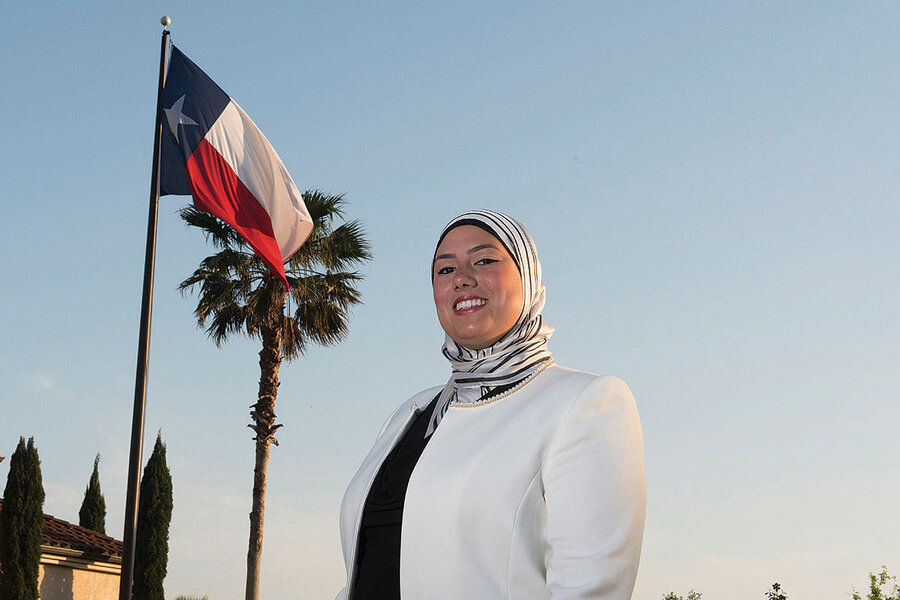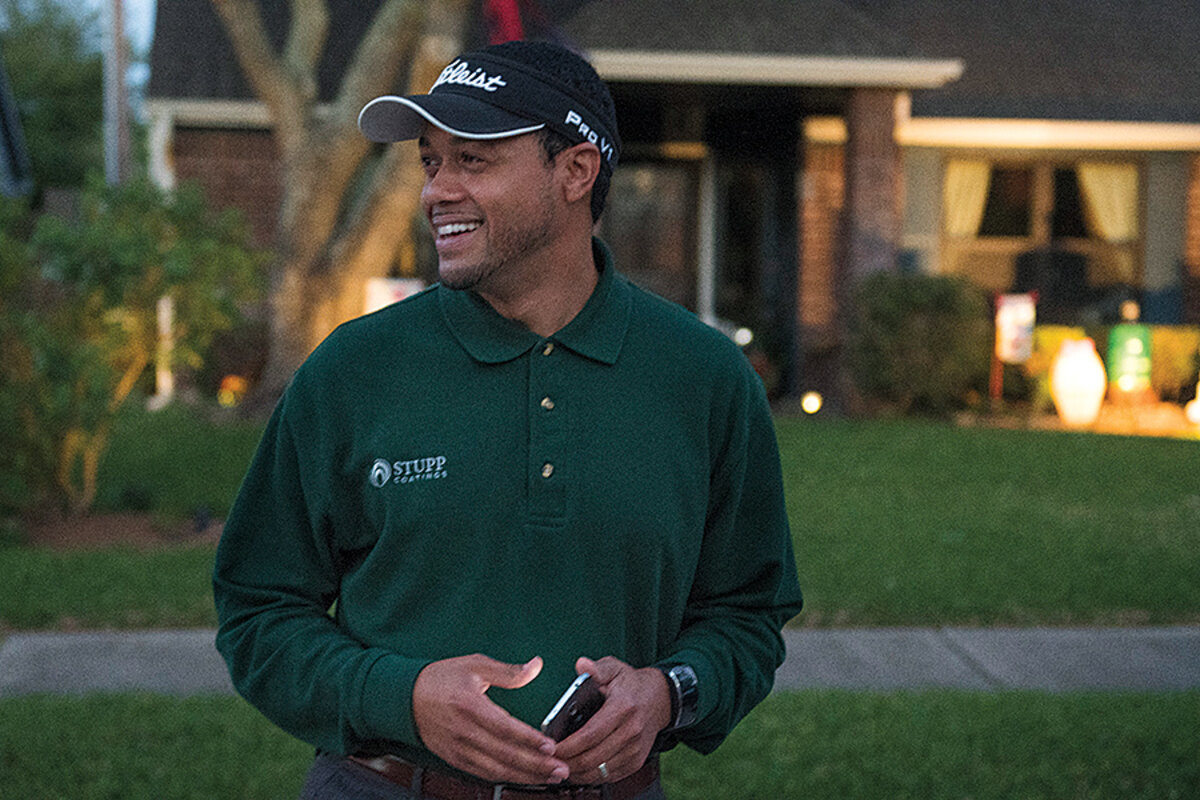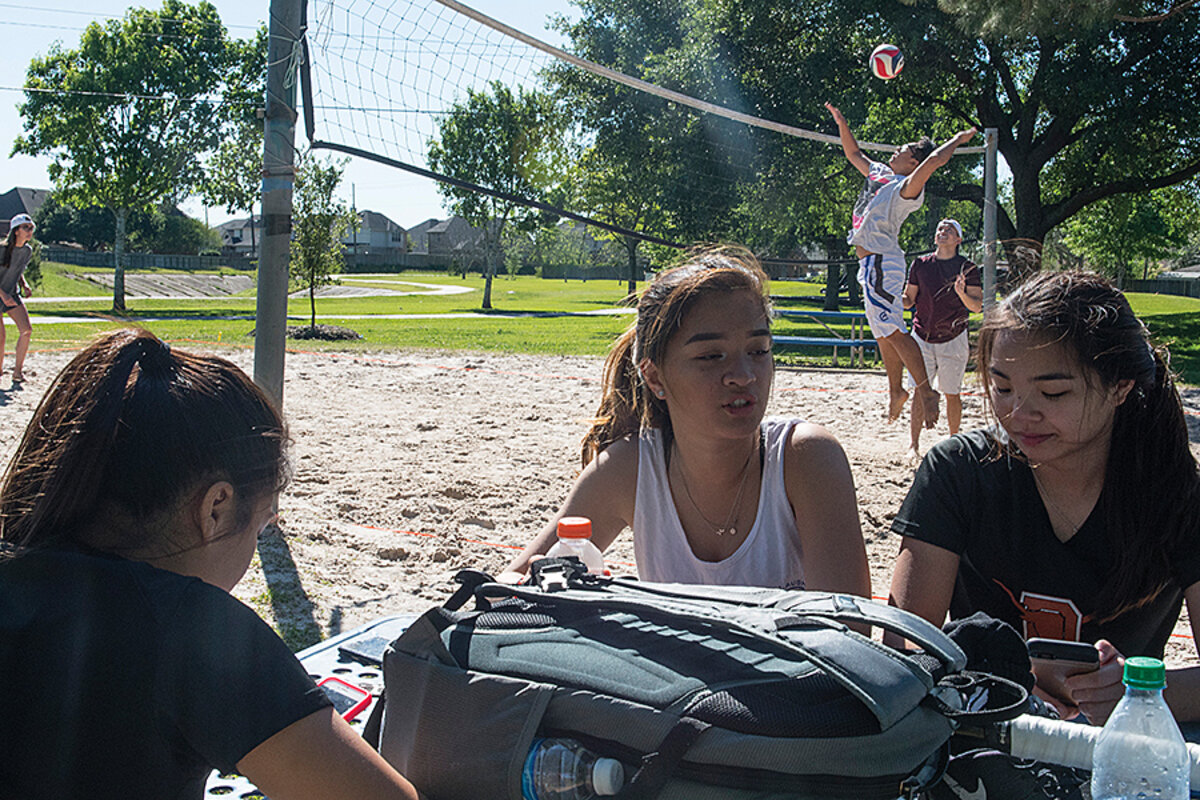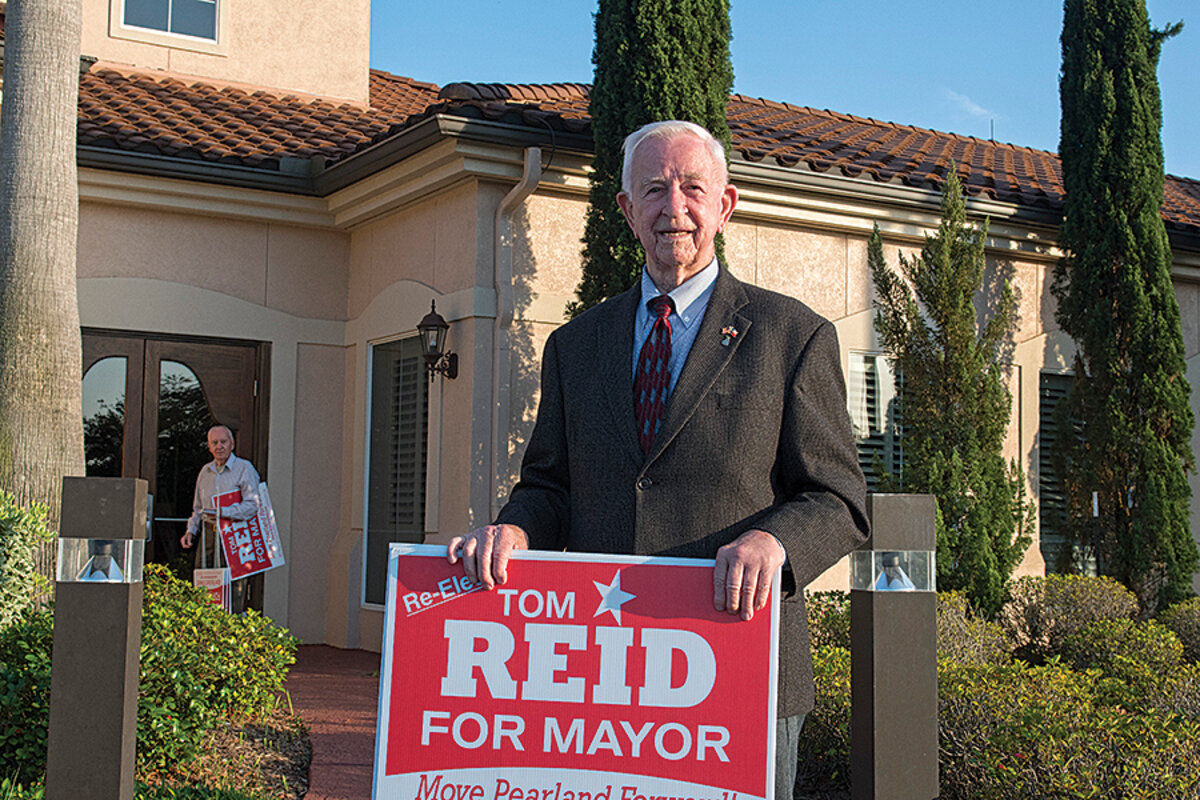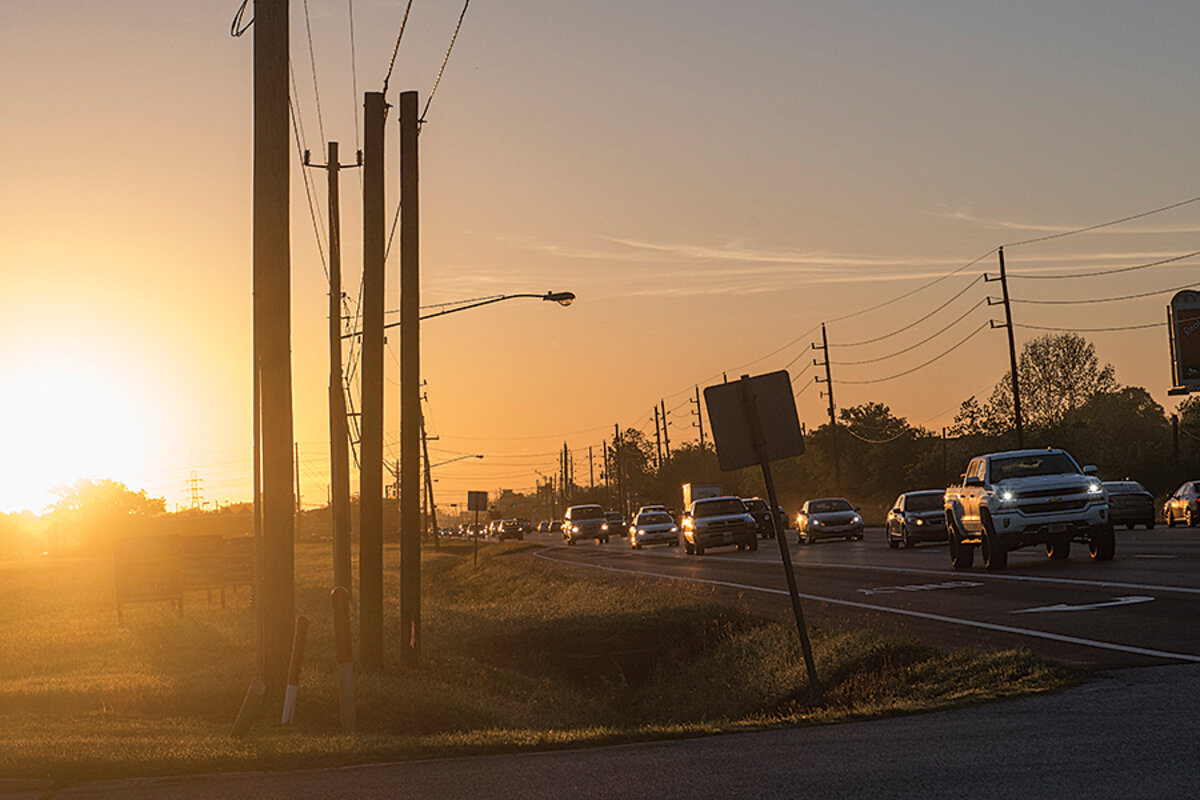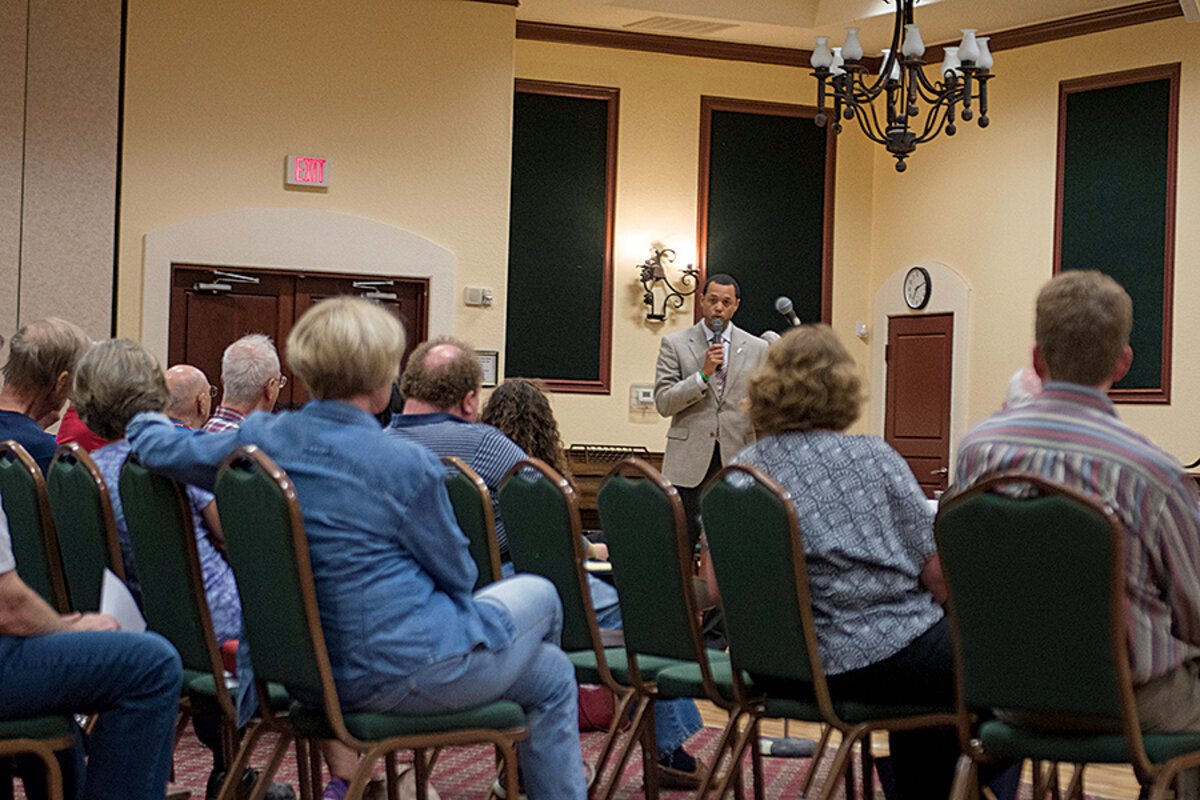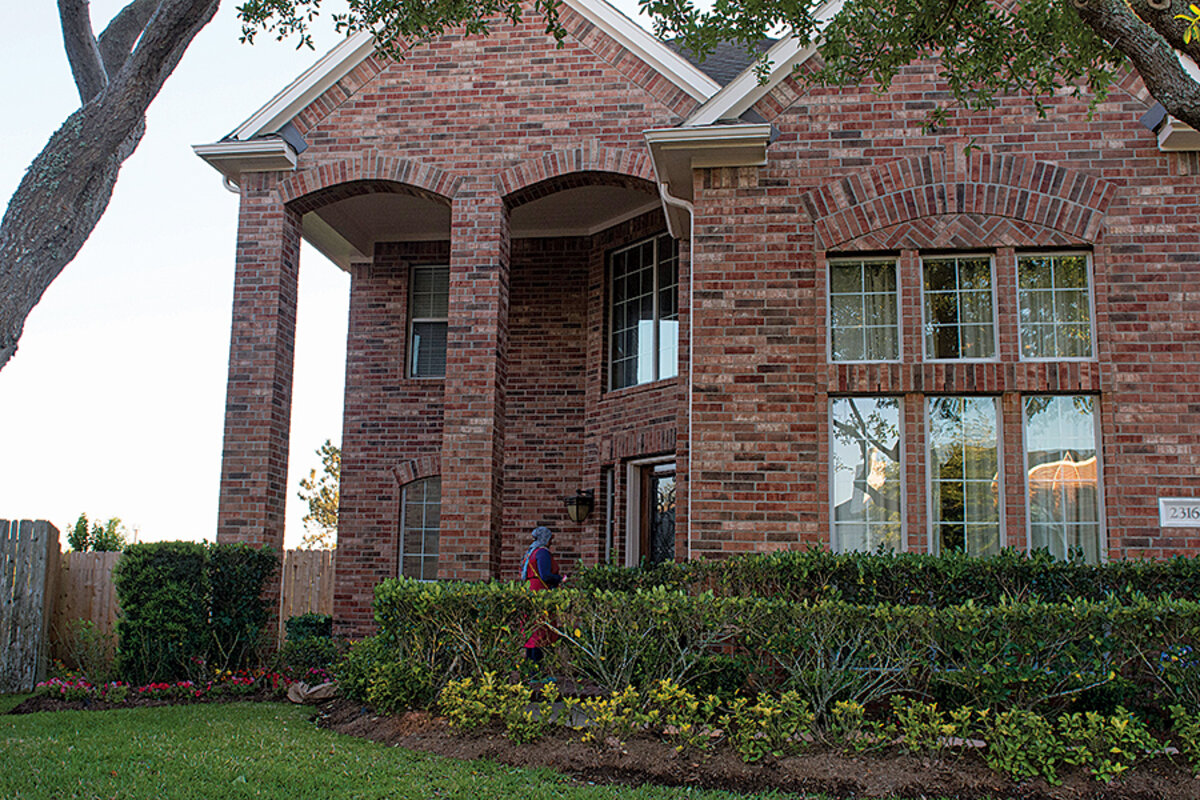Suburbia's new face
Loading...
| PEARLAND, TEX.
The sun has already set by the time Quentin Wiltz – oil industry executive and political candidate – approaches the last ranch house in a subdivision of this Houston suburb. A Latino man stands on his front lawn, a hose at his feet. In the fading light, he has the glazed look of someone relieved to be home from work.
Mr. Wiltz, an African-American in gray slacks and a green polo shirt, goes into his spiel: I’m running for mayor and I’d like your support. The homeowner, Efren Lara, says he didn’t know there was an election coming up. Wiltz edges in closer and reminds him when polling stations will be open. “What time can you make it?” he asks, pressing the man to vote. Mr. Lara says he works long hours at an Exxon refinery. Wiltz, who works for a company that makes pipelines, smiles and raises an arm. “Ah! You’re in the downstream and I’m in the upstream,” he says.
“We want to make some changes, OK?” Wiltz adds, talking about what he’d do as mayor. He takes down Lara’s phone number, then waves goodbye.
Two miles west, in a newer subdivision of brick facades and double garages, Dalia Kasseb rings another doorbell, pamphlets in hand. Ms. Kasseb, an Egyptian-born pharmacist, wears a patterned blue headscarf and carries a yellow Coach purse over her shoulder. A middle-aged black woman opens the door; three young kids spill out onto the lawn. “Hi! I’m running for city council to be a voice for all,” Kasseb begins. Then she launches into her political pitch.
Both the candidates and the residents they are wooing symbolize the new face of suburban Texas – and, to a certain extent, the rest of the United States. Once synonymous with middle-class whites, suburbs are now becoming America’s new melting pots. From Atlanta to Sacramento, suburban communities are rapidly diversifying as families of all different racial and ethnic groups move in search of better schools and their version of a white-picket-fence lifestyle.
While diversity has long been written into the code of cities, suburbs are now challenging them as the new source of social and ethnic dynamism. Indeed, between 2000 and 2010, nonwhites accounted for nearly all of the suburban population growth in 78 of the top 100 cities, according to William Frey, a demographer at the Brookings Institution in Washington. Today more Latinos and African-Americans live in suburbs than in urban cores.
“Suburbs are changing very rapidly in terms of their racial and ethnic composition – and their affluence,” says Daniel Lichter, director of the Institute for the Social Sciences at Cornell University in Ithaca, N.Y.
Like many cities, Houston remains divided by race and ethnicity, and by wealth and poverty. But its middle-income suburbs are rapidly becoming a kaleidoscope in which no majority exists, a sign of where much of America is headed. (Texas, like California, is a majority-minority state.)
Nowhere is the transformation more evident than in Pearland, a dumbbell-shaped suburb on Houston’s southern edge. Its diversification is largely a result of the inexorable sprawl of this city, where residents keep moving farther out in search of lower-density living. Houston’s nine-county metropolitan area is larger than Massachusetts.
In 2000, Pearland had a population of 37,600. Today, it is the country’s eighth fastest-growing city, with 120,000 people. Along with the growth has come a reversal from a majority-white community to one where newcomers look more like Wiltz and Kasseb than the incumbents they are challenging.
Yet living in the same subdivision doesn’t necessarily mean living together. For old-timers in Pearland who remember a slower pace of life, the diversity and influx of newcomers sometimes feels like an intrusion. A gap has already opened up between the younger, multicultural new arrivals and the mostly white homeowners near the city’s old center.
Underlying the changing sociology – and politics – of America’s suburbs looms a fundamental question: Does their diversification represent a new kind of integration, or just a bunch of diverse groups coexisting side by side in their own enclaves – a tossed salad rather than a melting pot?
“We’re not threatened by each other,” says Stephen Klineberg, a sociologist at Rice University in Houston, of the area’s new diversity. “But we also don’t get to know each other.”
Pears are no longer farmed in Pearland, but horses and cattle still graze behind the housing subdivisions named for the ranches they replaced. The town was founded in 1892 by a Polish aristocrat who bought 2,560 acres of land near a railroad junction. Pearland slowly filled up with farming families, built schools and roads, and diversified into growing figs and rice. Oil derricks bobbed nearby. By 1960, a year after its incorporation, it had 1,497 residents.
Mayor Tom Reid, a World War II Navy pilot, moved to Pearland in 1965. He wanted to be closer to his work as project manager at the Johnson Space Center, 12 miles down what was then a country road. “I could go to work and my wife would say, ‘How was the drive?’ I’d say, ‘I saw a couple of guys and we waved to each other,’ ” he says.
The proximity to the Space Center attracted other aerospace families, and Pearland began to build better roads and sewer lines, anticipating future growth. Then in the 1990s, as Houston’s oil economy revved up, Pearland’s population doubled. The expansion of State Highway 288, a six-lane road to Houston, opened up the community to commuters, and new housing projects spread across the landscape.
Part of Pearland’s growth, like that of many suburbs, is rooted in the perennial movement of people out of city cores. For all the hype of an urban renaissance, Americans continue to migrate to the low-density suburbs of car-dependent urban areas. Rich and childless whites cling to city centers, as do many new immigrants. But young families move outward where housing is cheaper and schools are often better.
As they do, they bring more diversity to suburbia, since nonwhite minorities now make up 44 percent of Americans ages 18 to 34. For African-Americans, a suburban home is a choice that their parents and grandparents were frequently denied. For immigrant families from Asia, spacious suburbs are among the reasons they moved to the US.
Not all suburbs are seeing racial mixing – or embracing the trend. Demographers point to a new form of “white flight” as older white families leave behind multicultural cities and suburbs for new exurbs, particularly in areas between the two coasts. “You can have increasing diversity and increasing segregation at the same time,” says Richard Wright, a geographer at Dartmouth College in Hanover, N.H.
From 1990 to 2010, Pearland went from being one of Houston’s most homogeneous suburbs to its second most diverse, a city where whites are outnumbered by Latinos, African-Americans, Asians, and other minorities. As many as 75 languages are now spoken in local schools.
“It’s a very dynamic and diverse place,” says Clay Pearson, the city manager, who moved here from Michigan in 2014. “At some level, you realize that’s part of the now and the future. For myself and a lot of people I’ve talked to, that’s an attraction.”
Mayor Reid is now 91. His office at City Hall, near the old center, faces west toward the newer subdivisions, past a tangle of traffic. Framed pictures from NASA space missions line his wall. In the corner stands a gleaming chrome shovel, a reminder that his job as mayor – a near-unbroken run since 1978 – is largely ceremonial; Mr. Pearson is the chief executive. Being mayor is also a part-time job, though Reid, who has crisp white hair, blue eyes, and jug ears, says he usually puts in a full workweek, even while he’s running for reelection.
“I’m retired and I’m doing something I love,” he says, switching into campaign mode. “My job is building a city, and I’m not through yet.”
As the demographics of many suburbs change, their politics are shifting, too – though often more slowly and subtly. Many suburban communities, including Pearland, are seeing more diverse slates of candidates run for local offices and new issues surface.
Yet traditional voting patterns endure. It’s often easier to target and win over diligent retirement-age voters than it is to woo new families with frenetic schedules. That’s why, on a midweek evening, Wiltz and Kasseb join other candidates who sit behind four trestle tables in a carpeted events room at a residential clubhouse for “active adults.” A scattering of older men and women, all white, fill three rows of seats. At the front sits Wiltz’s wife, Monique, and his eldest son. Kasseb’s husband sits facing her.
The rest of the lineup – Reid and eight candidates for council seats – are white. Only one of them is a woman.
Wiltz, dressed in a jacket and striped tie, sits next to Reid, who is all smiles as they shake hands. It’s the first meeting between the two since Wiltz told the mayor in January that he was running against him, after two unsuccessful bids for city council. When Wiltz gets to his feet, after Reid’s opening remarks, he holds up a finger and turns to the moderator.
“I want to clarify one thing,” he says. “Mayor Reid is not an opponent, he’s a friend.” (Reid, cast as Caesar, stares at his Brutus, impassively.)
Wiltz, who is in his mid-30s, grew up in Louisiana and attended a historically black college in Baton Rouge. He tells the forum that after he moved to Pearland in 2007, Reid wrote a recommendation letter for him to join the parks board. “And that’s where my career in service leadership started,” he says.
Then he pivots to his campaign themes: improving transportation, creating jobs, listening to residents. “I just want to provide new ideas and leadership for where we want to be and the city we want to become,” he says. “Thank you.”
Other candidates talk about their careers, their families, their ties to Pearland. What passes for policy debate is the stuff of municipal governance, from traffic snarls to flood drainage. Kasseb talks about “smart growth” and people staying healthy and having more parks.
Only one candidate, Jude Smith, a lawyer running for a council seat, speaks directly about the demographic changes. He moved to Houston three years ago with his wife, a doctor, who is Indian. “We looked around Pearland and saw people of every color from almost every country in the world,” he says. “That’s what I want to be a part of.”
After the speeches, a middle-aged woman stands up and identifies herself as a resident on the newer west side. “I see two cities here,” she says. “And because you represent the city, how are you going to draw these two parts together that have nothing to do with each other right now?”
Reid then launches into an explanation of how he solves problems by listening to all sides. “Some people have a fixed mind on a particular issue and don’t want to consider any other alternative,” he says.
Wiltz is back on his feet. “I like to walk,” he says, pacing toward the front row. He pauses.
The divide is real, he tells the woman, noting that he lives in what he prefers to call “the historic district.” What’s missing now is engagement and new leadership. He proposes holding quarterly town hall meetings around town. “We have to be more proactive,” he says.
Nobody mentions race or ethnicity, and the discussion reverts to traffic management. Later, over pizza, Wiltz explains he has learned not to speak bluntly about social divisions lest he offend. “I’m more coded now,” he says. Growing up in St. Martinville, La., a town of 6,000 residents, he understands that people get comfortable with the way things are and unnerved by rapid change.
Should Wiltz be elected mayor, one of his tasks will be to bring together a rapidly changing city with few unifying forces. Pearland is solidly middle-class: A starter house costs $140,000, and median household income is $97,000, much higher than in Houston. But newcomers rushing to downtown jobs barely brush shoulders with the mostly white retirees who tee off on the golf course weekday mornings or the older families that work and play near home.
Shopping habits reinforce a sense of division. Pearland has three Wal-Marts spaced several miles apart; residents refer to the one on the east side as “white Wal-mart” because of who shops there – and who doesn’t.
On election night, some Trump supporters waving Confederate flags drove the city’s main drag, says Wiltz, who took this as a racist affront. Nobody should assume that Pearland’s integration is a smooth one-way street, he says. “In these times, if you cherish and appreciate this diversity, we need to reach out to people who are different from us.”
Not far from the outskirts of Pearland stands the Sri Meenakshi Temple, its cream walls and wedding-cake lintels of Hindu gods rising above the flatlands. On weekends, thousands of Indian families come to pray at its shrines. Weddings take place in a modern building on the 26-acre site that also has a library, basketball court, and walking track.
The place was much more modest in 1978 when Vatsa Kumar emigrated from Bangalore, India: An 8-by-8-foot temple stood on the site, next to a trailer home where a single priest lived. Local ranchers were happy to sell plots to Indians in Houston who wanted a place to worship on weekends. “Land was cheap 40 years ago. We could get as much as we wanted,” says Mr. Kumar.
By 1982, the imposing temple that still stands today had been built, but it served a small Indian community living in the Houston area. Now the population has caught up with the temple’s ambition. Some 125,000 Indians live in Greater Houston, many in suburbs like Pearland.
“We’re still growing,” says Kumar, a retired nuclear engineer who helps run the temple. “A lot of Indian families have moved into this area.”
One of them is Rushi Patel. In 1985, when he was 9, his family immigrated to a small town in South Carolina where his father ran a motel. They were the only Indians in a segregated community, identified as neither black nor white. “What’s your American name?” the children asked him at school.
Two years later, the family moved to Darlington, S.C. The town was bigger, had a NASCAR course, and a handful of other Indian families. Mr. Patel studied accounting in college, then moved to Houston.
Together with his sister and brother-in-law, he owns a property development company that has two hotels in Pearland. On a recent morning, he sat in the lobby of the Hampton Inn, taking calls from staff at a new hotel going up near a petrochemical plant on the coast. A yard sign for Reid stood out front (“He’s a gentleman,” says Patel.)
In 2006, Patel bought a house on Pearland’s west side where he lives with his wife, an accountant who commutes to her job in Houston, and their two daughters. His sister lives nearby. His neighbors are a microcosm of the city’s growing diversity: a black-white couple with kids, a family of Middle Eastern descent, a white-Asian family, a black couple.
John Logan, a demographer at Brown University in Providence, R.I., says most metro areas now have what he calls “global neighborhoods” where no group has an absolute majority. Nearly all began as mostly white enclaves that integrated over time, he says. He believes that nonwhite immigrants who move into majority-white cities and suburbs act as a buffer that, over time, allows African-Americans to follow suit. And, given the vexed history of racial segregation and white flight, this immigrant-lined path could prove more stable than the unilateral movement of blacks.
“Global neighborhoods are made possible by immigration,” he says. “Hispanics and Asians [are] paving the way for integration of African-Americans.”
Immigration has certainly changed Houston’s demographics. In 1990, non-Hispanic whites were in the majority here (54 percent). By 2010, that share had dropped to one-third. Now 1 in 4 residents is foreign-born, compared with 1 in 7 nationally.
But that doesn’t mean that the old color lines – black and white, Latino and white – have been erased. As in many cities, patterns of segregation continue to shape where people live. Even in the suburbs, what looks like a mixed community from afar can turn out to be, on closer inspection, a balkanized spectrum of strangers occupying the same subdivisions.
Patel admits that busy commuting families in Pearland are often cocooned from their community, making it hard to build bridges. “They live next to each other. But they don’t know how to talk to each other,” he says. He smiles wryly. “I don’t know why I’m saying ‘they.’ ”
Ask Reid, the mayor, and he’ll tell you that it simply takes time for people to settle into a new community – especially when the town is growing as fast as Pearland. When he first moved here, he still went to his doctor and dentist in Houston, and attended church there. Gradually he found a local doctor, dentist, and Presbyterian church.
“It takes a while before you become part of a community,” he says. “We’re beginning to assimilate. There’s some people that say, ‘I sure wouldn’t want to live out there.... People are disorganized. Some of them don’t even know their neighbors.’ ”
The city has recruited more minorities into its police force, convened interfaith groups, and commissioned a diversity and inclusion study for its recreational services. Christopher Orlea, director of parks and recreation, says the goal is to roll out programs “that meet the desires of a cosmopolitan community and deliver a public service that is relatable to all residents.”
On May 6, Wiltz finished narrowly behind Reid in the mayor’s race (a third candidate took 5 percent). Kasseb polled first in her six-way race for a council seat. But no candidate in these races received more than 50 percent of the votes cast. So runoff elections for both positions will be held June 10.
Should Wiltz defeat Reid, he won’t quit his job in Houston. Yet he says that Pearland eventually needs a full-time mayor, not a figurehead, if it’s to manage its rapid growth and make sure that everyone feels represented at city hall.
“You can master-plan a neighborhood. But you can’t master-plan a community,” he says.
Postscript: On June 10, Mayor Reid defeated Wiltz, receiving 7,960 votes compared to 5,447 cast for Wiltz. In the other runoff vote, Kasseb lost to Woody Owens, who had previously served on the city council.




